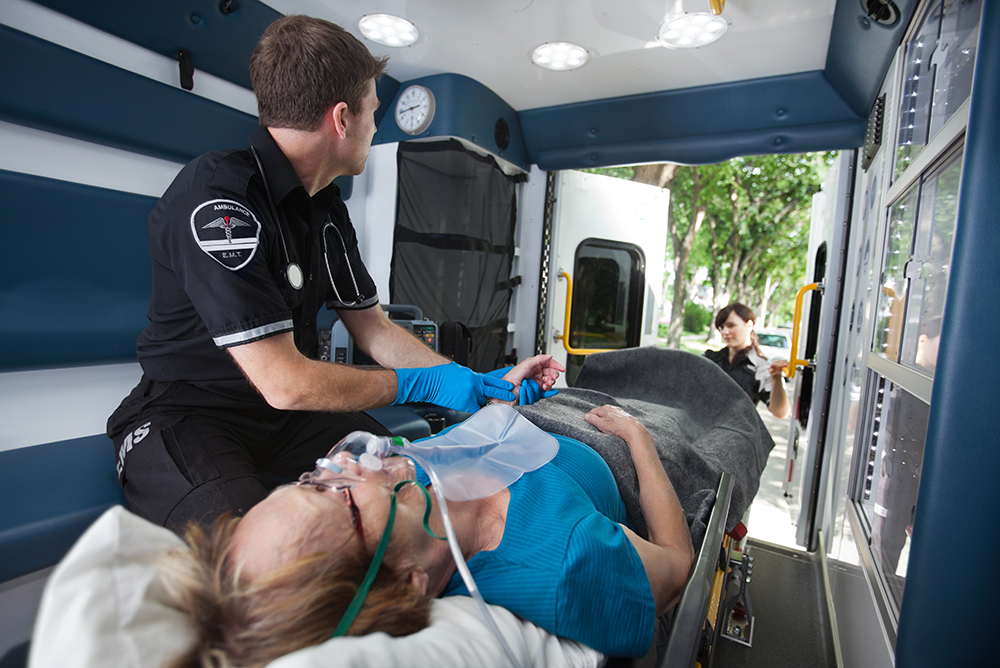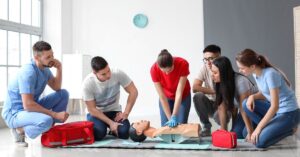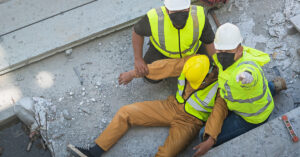Paramedics, who are among the most highly-skilled of Emergency Medical Services (or EMS) professionals, are in many ways like real-life superheroes, tending to people in their time of greatest need. While most of us hope to never see a paramedic on our doorstep, their appearance in times of distress can be critical to patient survival and recovery. Here is a small glimpse of what it’s like to be a medical first responder.
1. THEY ARE NOT JUST “AMBULANCE DRIVERS.”
Paramedics are skilled medical professionals who have undergone many hours of rigorous training—far more than your average emergency medical technician (EMT). “A lot of people call us ambulance drivers,” says Nick, a critical care paramedic in New York. “It aggravates us because driving is such a small part of the job. Emergency medicine is what we’re doing.” Medical tasks paramedics regularly carry out include administering medication, starting IVs, intubating unconscious patients to help them breathe, intraosseous (bone) injections, reading electrocardiograms (EKGs), needle chest decompression (sticking a needle into the ribs to fix a collapsed lung), and differentiating between different types of heart attacks.
2. THEIR JOB IS NOT ALL BLOOD, BRUISES, AND BROKEN BONES.
Contrary to the popular image of emergency medical workers, some paramedics handle a relatively small number of traumatic injury calls. In New York and other big cities, the emergency medical system can be large enough to be split into specific specialties. Consequently, explains Thomas Rivalis, a New York paramedic, city EMTs are often sent to scenes of trauma, while paramedics respond to medical calls (think heart attacks, strokes, and seizures). “If you are in a car accident, the person pulling you out of the car is most likely an EMT,” he says. “If you see someone clutch their chest and fall over, and you call 9-1-1, that is most likely going to be a paramedic.”
But in smaller suburban and rural systems, where resources are scarcer, it is more common for duties to overlap and paramedics to handle all types of calls.
3. THEY MIGHT ALSO HAVE TO PUT OUT FIRES—LITERALLY.
Emergency medical systems vary greatly by location, resulting in significant differences in the work paramedics carry out. Bruce Goldthwaite, a shift captain and paramedic in Franklin, New Hampshire, works in a dual role system where paramedics not only respond to all types of calls, but where all emergency medical workers work as firefighters as well. Bruce explains that on a typical day, he “could go on an ambulance call, to a building fire, on a technical rescue … On an odd day you could be on all of those trucks in a single shift.”
There are other common differences. Rural and suburban EMTs, unlike their urban counterparts, are frequently volunteers, drawing a paycheck if they choose to move on and become paramedics. And it’s typical for small-town EMS workers to wait for calls in a station house outfitted with beds and a lounge, unlike New York medics, who spend their time between calls waiting on an assigned corner in an ambulance.
4. THEY FIND WAYS TO FILL THEIR DOWN TIME.
While the job of an EMS worker is all about action, it also involves a fair amount of time sitting in an ambulance (or a station, depending on where you work) waiting for disaster to strike. Every paramedic has their preferred way of filling the time. “HBO Go is a thing,” Thomas says. “You’ve got guys who will binge-watch a whole series of Game of Thrones. Some people read. Then you’ve got the super tech who wants to bring in cardiac textbooks.” Since paramedics are subject to regular recertification, they sometimes use their downtime for studying. Thomas adds, however, that “bringing any type of napping accoutrement (pillows, blankets) is frowned upon.”
5. TRAFFIC IS THEIR BIGGEST HAZARD.
While driving may not constitute the most significant part of a paramedic’s job, it is one of the most dangerous. Nick has been in over 10 collisions in the course of his EMS career. “Far and away the driving is the most dangerous aspect,” he says. “When you’re driving with sirens and going through red lights and trying to move aggressively through traffic, it’s inherently dangerous.”
Compounding the issue is the fact that the patient compartment of most ambulances, unlike the cab, is essentially an aluminum box that doesn’t offer a lot of protection. Medics take care to secure their patient in the stretcher but frequently remain untethered themselves while working, putting them at risk of being flung around in the event of a wreck. The American ambulance manufacturing industry is taking steps to adopt safer crew restraint systems similar to those in Europe and Australia, but change is slow in coming.
6. ABOUT THAT LOVELY SOUND …
Few people would describe the sound of an ambulance siren as “nice.” Urban dwellers, in particular, loathe the shriek that seems to form a constant backdrop to city life. But how do paramedics, who hear sirens far more than anyone else, feel about this tool of their trade?
“People give you nasty looks when you turn on a siren. Like ‘oh, my eardrum,’” Thomas says. “It’s not that much quieter inside the cab.” Particularly pernicious is the rumbling siren known as the Howler, which is a feature on some police cars and ambulances. “The button actually says ‘wear hearing protection when you use this,’” Thomas says. “You think any of us even have hearing protection?” Nick, however, insists that he has gotten so used to sirens that he can sleep through them.
7. STAIRS ARE THEIR NEMESIS.
Paramedics dread calls that involve stairs. Throw in a heavy patient unable to get up and down steps by themselves, and you have a recipe for paramedic back strain. These jobs can be particularly brutal in New York, where buildings are tall and pre-war structures often lack an elevator. Thomas describes arriving at a building to tend to a patient on the 15th floor, only to find that the elevator was out of service. “Just as we were getting ready to carry her down,” he says, “the repair guys finished fixing the elevator. I’ve never been so happy.”
8. THE TRAINING IS VERY TOUGH.
Becoming an entry-level EMT (or EMT-B, for Basic) requires between 120 and 150 hours of schooling, but acquiring the skills to become a paramedic requires many more—typically around 1200 to 1800 additional hours. Like a lot of medical training, it is rigorous and the hours long. Nick refers to his own training as “just grueling … It’s basically a straight year where you’re not going to see your friends, you’re not going to see your family.” Not everyone makes it through on their first try. And, unfortunately, if you drop out, you have to start all over again.
9. THE PAY IS NOT NECESSARILY GREAT.
For people who spend their time saving lives, EMS workers are not always well-compensated. The median annual wage for paramedics and EMTs in 2015 was $31,980. Within that, there is a broad pay range, with EMTs (volunteer units aside) often making considerably less (around $10 an hour in some places), and the best-paid paramedics making over $60,000.
10. DARK HUMOR IS PRETTY COMMON.
Sometimes a few jokes are necessary to get through a day filled with illness and injury. Paramedics are known to rely on this strategy, and their wisecracks frequently take trip to the dark side. “It’s just terrible, terrible dark humor all the time,” Nick says. “Sometimes people who are not in medicine are aghast. When you face mortality all the time, you have a different perception of death.”
11. THEY CAN BE SUPERSTITIOUS.
Actors avoid speaking the name of Macbeth, instead referring to the famous Shakespeare work as “the Scottish play.” And they would rather have someone tell them to “break a leg” than to wish them good luck. Paramedics, it turns out, have their superstitions too. Thomas says that he avoids uttering the words “slow” or “quiet” (he uses the “S-word” and the “Q-word”) on the job, lest they invoke the wrath of the “EMS gods” and bring about a tough shift. In addition, some paramedics earn a reputation as “black clouds.” “You work with that one person,” he says, “and you know that there’s going to be a cardiac arrest or a five car pileup.”
12. THEY’RE HERE TO HELP.
Paramedics earn their superhero reputation for a reason: Most are drawn to the job out of an earnest desire to help people. Bruce says that he has always enjoyed helping others, but that he was set on his particular path after watching a paramedic attend to his father when he was having a cardiac arrest. “It was pretty impressive,” he says, “and I thought if you can help people in that way, I like it. Sign me up.” For Thomas, one of the biggest rewards is the opportunity to bring “dignity to people who don’t often get to experience it—people who have dependence issues, people who are homeless. You’re interacting with these people in a position of authority, and you can use this to make their day worse than it is, or you can bring a little dignity to their lives.”
13. THEY LIKE IT IF YOU’RE NICE.
Because they deal with people in distress, a paramedic’s job is often thankless. It helps if you’re nice. “We’re human. We make mistakes,” Thomas says. “We have bad days, we have good days. We all come to work to help people and we try our best. But it’s up to the person that we’re helping to meet us half way. We know we’re coming in on the worst day of your life—but the best thing that you can do is just give us your cooperation. You want to get to the hospital. We want to take you to the hospital. But we have to assess you first.”
14. THE ONLY WAY TO KNOW WHETHER YOU’RE A PARAMEDIC IS TO GO ON A FIRST CALL.
Bruce emphasizes that much of what a paramedic sees on a daily basis the general public will never have to encounter in their lives. “It’s a very gratifying job,” he says, “but it’s a tough job. You see a lot of things that you can’t get rid of.” Despite the many hours of training and simulations that go into certification, it’s not possible for an EMS worker to know how they will react in a real situation until they are actually in one. “You can do all the classroom work and all the preparatory imagining of what it’s going to be like when you’re standing in front of a person who’s dying,” Nick says. “Sometimes people just can’t handle it, and you can’t really guess who it’s going to be.” He adds, however, that he took to the job pretty quickly. Fortunately for the public, people who have what it takes to be a paramedic are out there.
——-
Despite all of these stressful notes of work every paramedic is a superhero!!! If you are an EMT, EMS, healthcare provider and in need of Heartsaver CPR AED, First Aid, ACLS, BLS, PALS, or re-certification enroll here. CPR123 is the leading AHA authorized training center in the United States of America! Learn more: www.cpr123.com
Article source: Metal Floss I All Photos via CPR123







